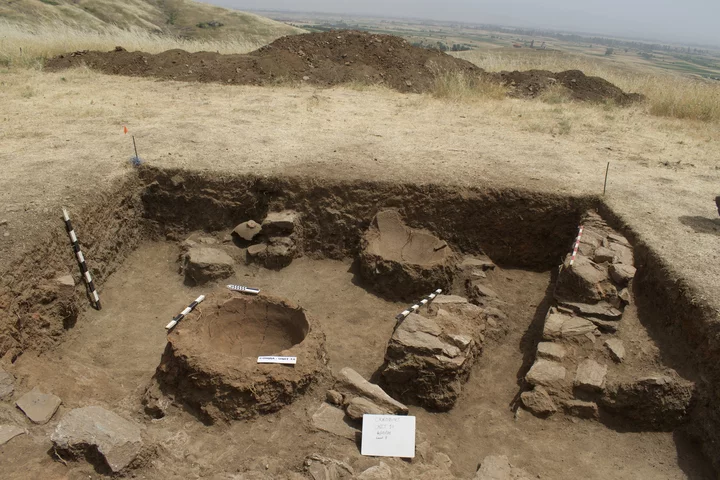Archaeologists and student researchers carefully excavate the ancient site in Crnobuki, North Macedonia. | Photo courtesy of Cal Poly Humboldt’s Cultural Resources Facility.
###
Press release from Cal Poly Humboldt:
For years, archaeologists believed the ruins in North Macedonia — first excavated more than 15 years ago — were the remains of a military outpost built to defend against Roman attacks.
But recent excavations, bolstered by cutting-edge technology and the discovery of an ancient coin, reveal a much larger story. Researchers from Macedonia’s Institute and Museum–Bitola and Cal Poly Humboldt are uncovering an ancient city, predating the Roman Empire by centuries, or possibly even millennia.
Near the village of Crnobuki, this site — known as the archaeological site of Gradishte — opens a window into the history of the Macedonian civilization before Alexander the Great, explains Engin Nasuh, curator-advisor archaeologist at the National Institute and Museum–Bitola.
“We’re only beginning to scratch the surface of what we can learn about this period,” Nasuh says.First mentioned in literature in 1966, Nasuh says the site remained a mystery for decades — until now. Archaeological excavations over the past few years have begun to uncover new insights into the size, scope, and influence of the site.
In 2023, modern technologies, including ground penetrating radar and cutting-edge drone-deployed LIDAR acquired with funding from Cal Poly Humboldt’s College of Arts, Humanities & Social Sciences dean’s office, revealed a once thriving city. The acropolis spans at least 7 acres; notable structures to date include a possible Macedonian-style theater and a textile workshop.
Originally, researchers believed the city was built during King Philip V’s reign (221-179 BCE). But its origin was pushed back after the discovery of a coin, minted between 325-323 BCE, during Alexander the Great’s lifetime.
Thanks to additional recent discoveries such as axes and fragments of ceramic vessels, researchers now believe humans began occupying it as far back as the Bronze Age (3,300-1,200 BCE).
The discoveries not only shed new light on North Macedonia’s past, they contribute to a deeper understanding of ancient Western civilization.
The ancient Macedonian state, one of the first modern states in Europe, had an enormous impact on the world, Nasuh explains. “It is a civilization that played a major role in today’s understanding of the world and the desire to connect different civilizations and cultures.”
Archaeologists have so far unearthed stone axes, coins, a clay theater ticket, pottery, game pieces, and textile tools. Dating of some of these artifacts, including charcoal and bone, dates the site between 360 BC and 670 AD, according to Nasuh. These discoveries provide tangible evidence of a thriving city before the rise of Rome.
This is a once-in-a-lifetime discovery, explains Nick Angeloff, Cal Poly Humboldt Anthropology professor and archaeologist.
“This discovery is significant,” says Angeloff. “It highlights the complex networks and power structures of ancient Macedonia, especially given the city’s location along trade routes to Constantinople. It’s even possible that historical figures like Octavian and Agrippa passed through the area on their way to confront Cleopatra and Mark Antony at the Battle of Actium.”
Angeloff adds that the site may be the lost capital city of the Kingdom of Lyncestis, Lyncus—an ancient settlement and hub for the Upper Macedonian Kingdom that was settled in the seventh century BCE. It’s also possibly the birthplace of Queen Eurydice I, the grandmother of Alexander the Great. Eurydice played a significant role in shaping the political landscape of the region.
Students, faculty, and researchers from National Institute and Museum–Bitola and Cal Poly Humboldt are working to continue uncovering the full story of this ancient city. This ongoing work promises to reveal more about the intricate networks and vibrant culture of ancient Macedonia, offering valuable insights into the development of early European states and their influence on the world.
“All these studies are just a small part of the research of early European civilizations,” Nasuh says. “I see it as a large mosaic, and our studies are just a few pebbles in that mosaic. With each subsequent study, a new pebble is placed, until one day we get the entire picture.”

CLICK TO MANAGE